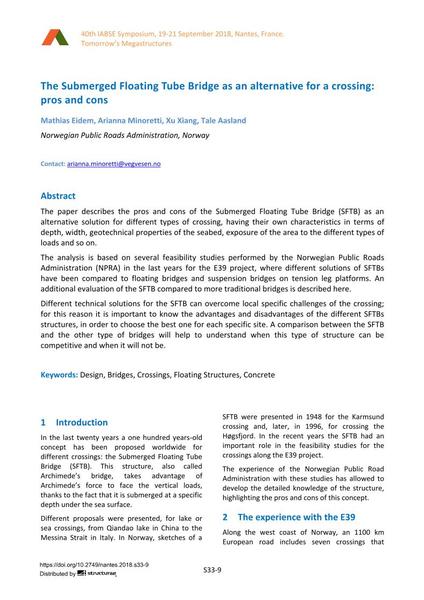The Submerged Floating Tube Bridge as an alternative for a crossing: pros and cons

|
|
|||||||||||
Détails bibliographiques
| Auteur(s): |
Mathias Eidem
(Norwegian Public Roads Administration, Norway)
Arianna Minoretti (Norwegian Public Roads Administration, Norway) Xu Xiang (Norwegian Public Roads Administration, Norway) Tale Aasland (Norwegian Public Roads Administration, Norway) |
||||
|---|---|---|---|---|---|
| Médium: | papier de conférence | ||||
| Langue(s): | anglais | ||||
| Conférence: | IABSE Symposium: Tomorrow’s Megastructures, Nantes, France, 19-21 September 2018 | ||||
| Publié dans: | IABSE Symposium Nantes 2018 | ||||
|
|||||
| Page(s): | S33-9 | ||||
| Nombre total de pages (du PDF): | 8 | ||||
| DOI: | 10.2749/nantes.2018.s33-9 | ||||
| Abstrait: |
The paper describes the pros and cons of the Submerged Floating Tube Bridge (SFTB) as an alternative solution for different types of crossing, having their own characteristics in terms of depth, width, geotechnical properties of the seabed, exposure of the area to the different types of loads and so on. The analysis is based on several feasibility studies performed by the Norwegian Public Roads Administration (NPRA) in the last years for the E39 project, where different solutions of SFTBs have been compared to floating bridges and suspension bridges on tension leg platforms. An additional evaluation of the SFTB compared to more traditional bridges is described here. Different technical solutions for the SFTB can overcome local specific challenges of the crossing; for this reason it is important to know the advantages and disadvantages of the different SFTBs structures, in order to choose the best one for each specific site. A comparison between the SFTB and the other type of bridges will help to understand when this type of structure can be competitive and when it will not be. |
||||
| Mots-clé: |
design béton ponts
|
||||
